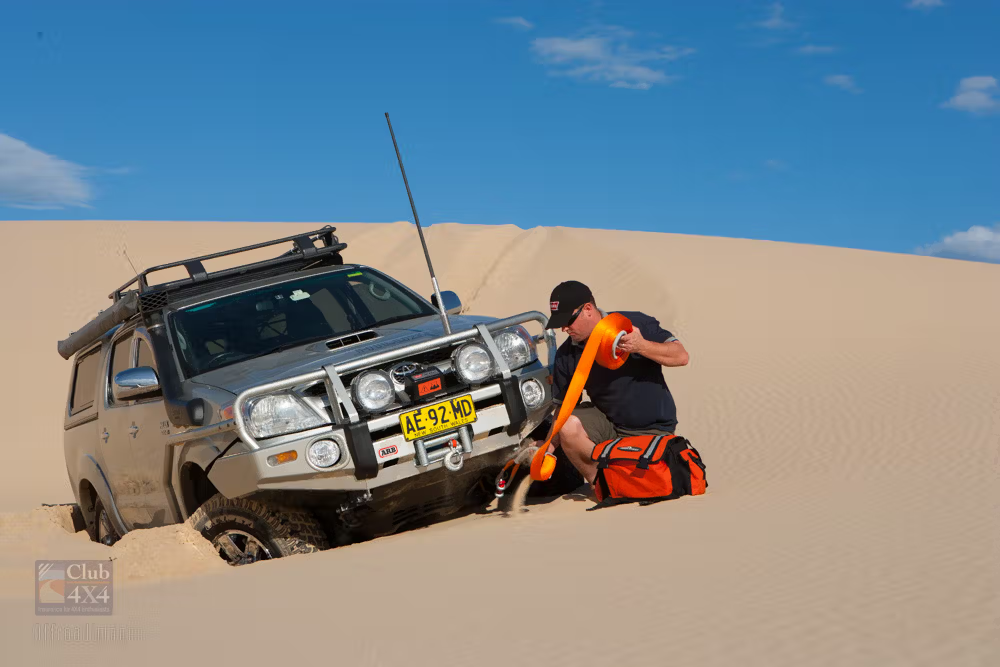If I was to ask you what your most important recovery tool would be, what would your reply be?

ARB photography by Offroad Images
Would it be a snatch strap?
Would it be a winch?
Maybe it’s your favourite shovel?
This item is something a 4WDer will use often, but most people wouldn’t view it as a piece of recovery gear.

We have photographed a huge quantity of recovery gear over the years, both as product shots and videos showing how things are done, and I am always amazed at the huge variety of recovery gear that keeps being developed for the off-road market. Its amazing to think that there are so many successful products created to help people like you and I when we get stuck in the middle of nowhere.

One set of shots rings a bell when we were photographing a huge variety of recovery gear all in one image and the client couldn’t understand why I placed this item into the group shot saying… “That’s not recovery gear!”
I have said it before many times, and I will say it again. If you go 4WDing and don’t get stuck somewhere, you’re probably not 4WDing. But if you do get stuck somewhere on your own, there is one piece of equipment that can help you recover yourself without the assistance of another vehicle.
Has anyone guessed it yet?

You can get bogged on a muddy hill, a rocky track, a slippery section of clay, or even a dry creek bed; you can get stuck in the sand of your favourite beach destination, and I could predict that the most common cause of your vehicle becoming bogged will be tyre pressures.
If you are on your own, no number of snatch straps will help you. If there are no trees around, a winch will be difficult to assist you.
The number one tool underestimated in your recovery kit is the humble tyre deflator or tyre pressure gauge.

We have been bogged many times where all we did was let the tyres down a few extra psi to allow us to extract the vehicle from the site. Unfortunately, tourists have been known to get bogged in the desert and have perished because they didn’t understand the situation. The recovery people have come in, let the tyres down on the vehicle and driven straight out of the trouble spot.

Now you could do this with a stick or rock or even your keys by simply pressing in the valve to let the air extract from the tyre and counting how many seconds you released air for before doing the same with the other tyres. Looking at the way the tyres are changing shape will provide you some idea of how far you have reduced the pressures, but this is extremely inaccurate of course and a last resort. Hopefully though, this will provide you the opportunity of extending the tread of each tyre, giving you additional surface area at the contact patch or foot print of your tyres to hopefully grab traction and get you going again.
This isn’t going to always be that easy, but I can assure you that most people we help out of a stuck situation have usually been able to get going themselves simply by reducing their tyre pressures.

Imagine the situation when you are heading down the beach with a bunch of mates and whilst they are all successfully making good ground, you have taken the wrong line and become stuck. You might choose to call for their help over the radio, or you might quickly drop a couple of psi out of each tyre and continue your way without anyone realising that you were even needing a recovery.

So next time you set up your recovery kit, don’t forget the importance of a good quality tyre deflator. It might just save you in a tricky spot.
Tyre deflators, tyre pressure gauges or even that stick could save you one day.

But don’t forget, whenever you let your tyres down, before heading onto the fast bitumen again, ensure you bring your tyres back up to highway pressures. In the same way that reduced pressures increase your tyres’ contact patch, they also increase tyre flexibility, which generates heat that can destroy a tyre very quickly if it is travelling too quickly and/or carrying too much weight for the pressure.

If you’d like to learn more about tyre inflation and deflation equipment, you can check out my recent article on the topic. If you’re not sure what recovery gear to take 4WDing, I’ve also recently published articles on what a basic kit should include, how to use recovery gear, the benefits of soft shackles and how to use recovery boards with some of their history too.
“Cheers”
-Michael Ellem
Offroad Images

The Campfire – Feedback
Just like sitting around the campfire, we would love to hear what you have to say. You can be involved simply by entering your comments below.
Also… we will be featuring stories about photography tips and tricks, 4X4 preparation, build planning and maintenance, as well as featuring inspirational locations for you to visit in your 4X4. So please get involved and let us know what you’d like to hear about. If you have any requests for stories to be featured in campfire or would like to provide feedback about this article, please send us a message on our social links:
Instagram: @offroadimages
Facebook: @offroadimages
YouTube: youtube.com/OffroadImages
Website: www.offroadimages.com.au
As 4X4 enthusiasts who live for the opportunity to create awesome imagery anywhere in Australia, we know that our vehicle assets are covered wherever we travel to create that shot, as we are insured by Club 4X4.


